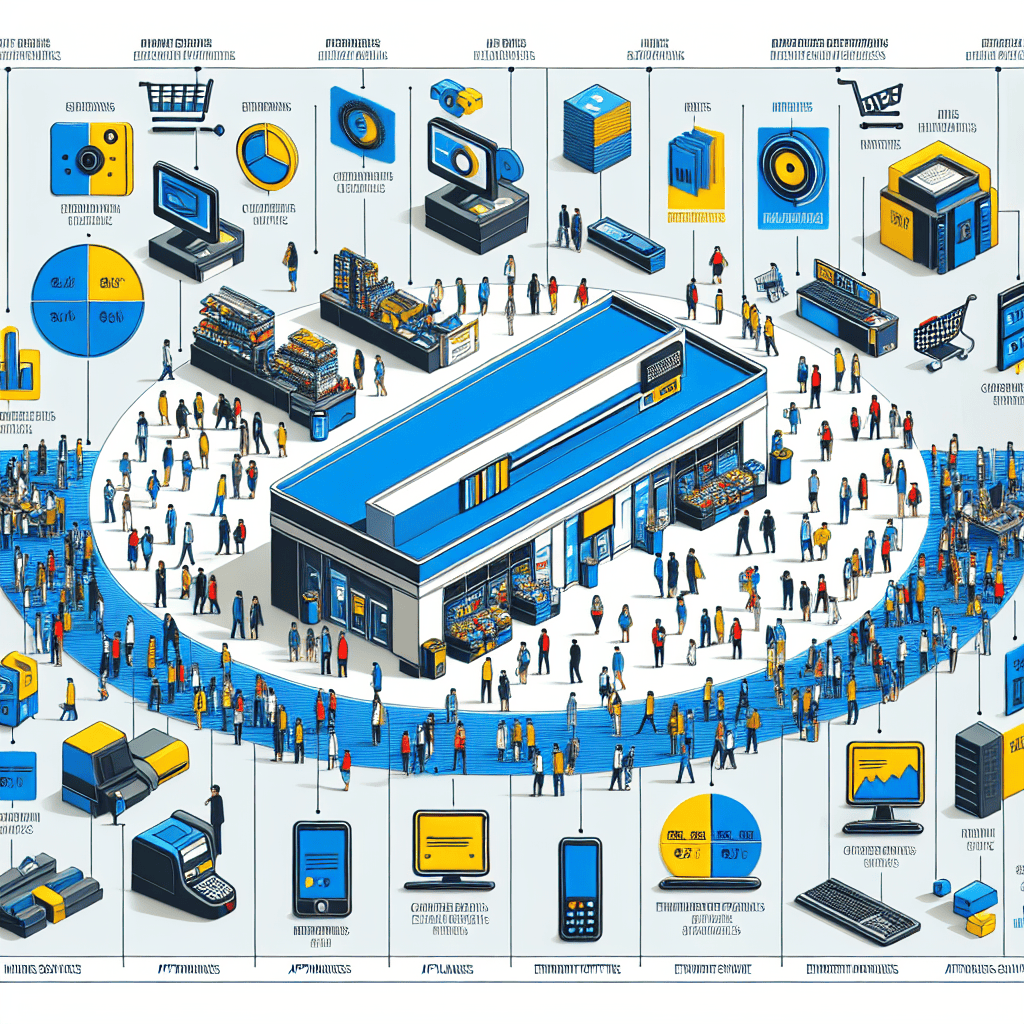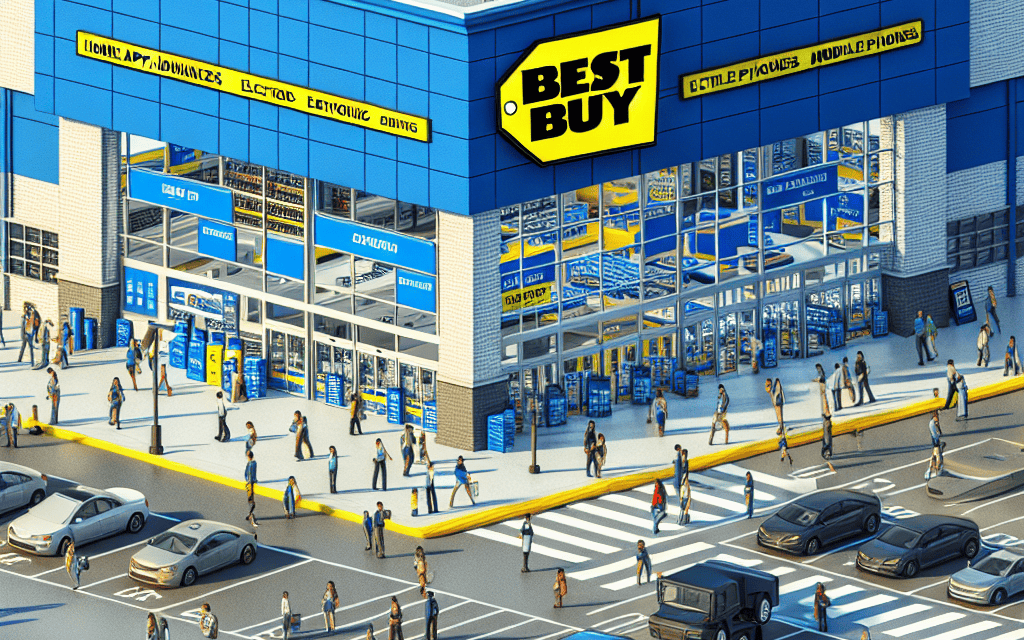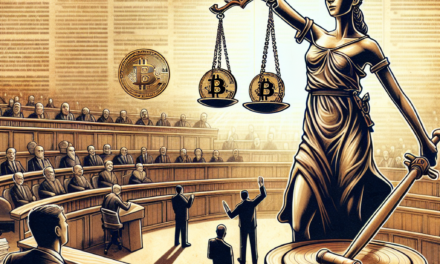“Unveiling Insights: Navigating Best Buy’s Market Dynamics”
Introduction
In-Depth Analysis: Best Buy Co. Inc.
Best Buy Co. Inc., a leading multinational retailer of consumer electronics, appliances, and technology products, has established itself as a dominant force in the retail industry. Founded in 1966 and headquartered in Richfield, Minnesota, Best Buy has evolved from a small audio specialty store into a comprehensive provider of a wide array of electronic goods and services. The company operates through a network of physical stores across the United States, Canada, and Mexico, as well as a robust online platform, catering to a diverse customer base. Best Buy’s business model focuses on offering competitive pricing, a broad product selection, and exceptional customer service, which are supported by its knowledgeable staff and innovative solutions. In recent years, the company has embraced digital transformation, enhancing its e-commerce capabilities and integrating technology-driven services to meet the changing demands of consumers. This analysis delves into Best Buy’s strategic initiatives, financial performance, market position, and future prospects, providing a comprehensive overview of the company’s operations and its role in the dynamic retail landscape.
Financial Performance And Growth Strategies Of Best Buy Co. Inc.
Best Buy Co. Inc., a leading consumer electronics retailer, has demonstrated resilience and adaptability in the face of a rapidly evolving retail landscape. The company’s financial performance and growth strategies have been pivotal in maintaining its competitive edge. Over recent years, Best Buy has navigated various challenges, including the rise of e-commerce giants and shifting consumer preferences, by implementing strategic initiatives that have bolstered its market position.
Financially, Best Buy has shown commendable performance, with steady revenue growth and robust profitability. The company’s ability to generate consistent revenue streams can be attributed to its diversified product offerings and strong customer service. Best Buy’s focus on high-margin categories, such as appliances and services, has contributed significantly to its bottom line. Moreover, the company’s commitment to cost management and operational efficiency has further enhanced its financial health. By optimizing its supply chain and leveraging technology to streamline operations, Best Buy has managed to reduce costs and improve profit margins.
In addition to its financial performance, Best Buy’s growth strategies have played a crucial role in its sustained success. One of the key strategies has been the enhancement of its omnichannel capabilities. Recognizing the importance of a seamless shopping experience, Best Buy has invested heavily in integrating its online and offline channels. This approach has not only improved customer satisfaction but also increased sales by providing consumers with multiple touchpoints to engage with the brand. The company’s curbside pickup and same-day delivery services are prime examples of how it has adapted to meet the changing needs of its customers.
Furthermore, Best Buy has placed a strong emphasis on expanding its services segment. The company’s Geek Squad, a tech support and repair service, has been a significant growth driver. By offering comprehensive support services, Best Buy has been able to differentiate itself from competitors and build long-term customer relationships. Additionally, the company’s focus on health and wellness technology, including partnerships with healthcare providers, has opened new avenues for growth. This strategic diversification into emerging markets underscores Best Buy’s commitment to innovation and its ability to capitalize on industry trends.
Another critical aspect of Best Buy’s growth strategy is its commitment to sustainability and corporate responsibility. The company has set ambitious goals to reduce its carbon footprint and promote sustainable practices across its operations. By prioritizing environmental, social, and governance (ESG) initiatives, Best Buy not only enhances its brand reputation but also aligns itself with the values of socially conscious consumers. This focus on sustainability is increasingly important in today’s market, where consumers are more inclined to support companies that demonstrate a commitment to ethical practices.
In conclusion, Best Buy Co. Inc.’s financial performance and growth strategies have been instrumental in maintaining its leadership position in the consumer electronics retail sector. Through a combination of strong financial management, strategic investments in omnichannel capabilities, expansion of service offerings, and a commitment to sustainability, Best Buy has successfully navigated the challenges of a dynamic retail environment. As the company continues to adapt and innovate, it is well-positioned to capitalize on future opportunities and drive long-term growth.
Impact Of E-commerce On Best Buy’s Business Model
The advent of e-commerce has significantly reshaped the retail landscape, compelling traditional brick-and-mortar businesses to adapt swiftly to the digital age. Best Buy Co. Inc., a leading consumer electronics retailer, has been at the forefront of this transformation, navigating the challenges and opportunities presented by the rise of online shopping. The impact of e-commerce on Best Buy’s business model is profound, influencing various aspects of its operations, customer engagement strategies, and competitive positioning.
Initially, the surge in e-commerce posed a formidable challenge to Best Buy, as consumers increasingly turned to online platforms for their shopping needs. The convenience of online shopping, coupled with competitive pricing and a vast array of choices, threatened to erode Best Buy’s market share. However, rather than succumbing to the pressures of digital disruption, Best Buy embarked on a strategic overhaul to integrate e-commerce into its core business model. This transformation was not merely about establishing an online presence but involved a comprehensive rethinking of how the company could leverage digital tools to enhance customer experience and operational efficiency.
One of the pivotal strategies Best Buy employed was the development of a robust omnichannel approach. By seamlessly integrating its online and offline operations, Best Buy aimed to provide a cohesive shopping experience that capitalized on the strengths of both platforms. This approach allowed customers to enjoy the convenience of online shopping while still benefiting from the personalized service and immediate product access offered by physical stores. For instance, the introduction of services such as “buy online, pick up in-store” and “curbside pickup” exemplified Best Buy’s commitment to blending digital and physical retail experiences.
Moreover, Best Buy’s investment in technology and data analytics has been instrumental in refining its e-commerce strategy. By harnessing data insights, the company has been able to personalize marketing efforts, optimize inventory management, and enhance customer service. This data-driven approach not only improves operational efficiency but also fosters customer loyalty by delivering tailored experiences that resonate with individual preferences and needs.
In addition to these strategic initiatives, Best Buy has also focused on expanding its product and service offerings to remain competitive in the e-commerce arena. Recognizing the growing consumer demand for smart home technology, health and wellness products, and subscription services, Best Buy has diversified its portfolio to include these categories. This diversification not only attracts a broader customer base but also positions Best Buy as a comprehensive solutions provider in the consumer electronics market.
Furthermore, partnerships and collaborations have played a crucial role in Best Buy’s e-commerce evolution. By aligning with tech giants and leveraging third-party platforms, Best Buy has been able to extend its reach and enhance its digital capabilities. These alliances have facilitated access to cutting-edge technologies and innovative solutions, further strengthening Best Buy’s competitive edge in the digital marketplace.
In conclusion, the impact of e-commerce on Best Buy’s business model is a testament to the company’s resilience and adaptability in the face of digital disruption. Through strategic integration of online and offline operations, investment in technology, diversification of offerings, and strategic partnerships, Best Buy has successfully navigated the challenges posed by e-commerce. As the digital landscape continues to evolve, Best Buy’s commitment to innovation and customer-centricity will undoubtedly remain pivotal in sustaining its growth and relevance in the competitive retail sector.
Best Buy’s Sustainability Initiatives And Environmental Impact
Best Buy Co. Inc., a leading consumer electronics retailer, has made significant strides in its sustainability initiatives, reflecting a growing commitment to environmental stewardship. As the global community becomes increasingly aware of the pressing need for sustainable practices, Best Buy has positioned itself as a proactive participant in the movement towards a more sustainable future. This analysis delves into the company’s efforts to minimize its environmental impact, highlighting key initiatives and their implications.
To begin with, Best Buy has implemented a comprehensive recycling program that underscores its dedication to reducing electronic waste. Recognizing the environmental hazards posed by discarded electronics, the company has established itself as a leader in e-waste recycling. Through its in-store recycling program, Best Buy has facilitated the responsible disposal of millions of pounds of electronics annually. This initiative not only helps mitigate the environmental impact of e-waste but also raises awareness among consumers about the importance of recycling.
In addition to its recycling efforts, Best Buy has made significant investments in energy efficiency. The company has set ambitious goals to reduce its carbon footprint, aiming to achieve a 75% reduction in carbon emissions by 2030. To this end, Best Buy has undertaken various measures, such as upgrading its store lighting to energy-efficient LED systems and optimizing its supply chain operations to minimize energy consumption. These efforts are complemented by the installation of solar panels on several store rooftops, further underscoring the company’s commitment to renewable energy sources.
Moreover, Best Buy’s sustainability initiatives extend beyond its operations to include the products it sells. The company has prioritized offering energy-efficient products, such as ENERGY STAR certified appliances, which help consumers reduce their own environmental impact. By promoting these products, Best Buy not only supports sustainable consumer choices but also encourages manufacturers to prioritize energy efficiency in their product designs.
Furthermore, Best Buy has demonstrated a commitment to sustainable sourcing practices. The company has established guidelines to ensure that the materials used in its products are sourced responsibly. This includes efforts to eliminate conflict minerals from its supply chain and to promote the use of recycled materials. By holding its suppliers to high environmental standards, Best Buy is working to ensure that its products are not only innovative but also sustainable.
In addition to these initiatives, Best Buy has engaged in partnerships with various organizations to amplify its sustainability efforts. Collaborations with environmental groups and industry associations have enabled the company to stay at the forefront of sustainability trends and to implement best practices across its operations. These partnerships also provide a platform for Best Buy to advocate for broader industry changes that support environmental sustainability.
In conclusion, Best Buy Co. Inc.’s sustainability initiatives reflect a comprehensive approach to reducing its environmental impact. Through its recycling programs, energy efficiency measures, sustainable product offerings, and responsible sourcing practices, the company is making meaningful contributions to environmental stewardship. As Best Buy continues to evolve its sustainability strategies, it sets a benchmark for other retailers in the industry, demonstrating that environmental responsibility and business success can go hand in hand. By maintaining its focus on sustainability, Best Buy not only enhances its brand reputation but also plays a vital role in fostering a more sustainable future for all.
Competitive Positioning Of Best Buy In The Consumer Electronics Market

In the ever-evolving landscape of consumer electronics, Best Buy Co. Inc. has managed to maintain a significant presence, navigating the challenges and opportunities presented by a highly competitive market. As a leading retailer in the United States, Best Buy’s competitive positioning is shaped by a combination of strategic initiatives, market trends, and consumer preferences. To understand how Best Buy sustains its competitive edge, it is essential to examine the company’s strategic positioning, its response to market dynamics, and its ability to adapt to changing consumer behaviors.
Firstly, Best Buy’s strategic positioning is anchored in its commitment to providing a comprehensive range of consumer electronics and related services. The company has established itself as a one-stop-shop for technology enthusiasts and everyday consumers alike, offering a wide array of products from leading brands. This extensive product assortment is complemented by Best Buy’s focus on customer service, which is exemplified by its knowledgeable staff and the Geek Squad, a service that provides technical support and repairs. By prioritizing customer experience, Best Buy differentiates itself from online-only competitors, creating a value proposition that combines the convenience of e-commerce with the personalized service of brick-and-mortar stores.
Moreover, Best Buy’s competitive positioning is reinforced by its strategic use of omnichannel retailing. Recognizing the growing importance of digital channels, the company has invested significantly in its online platform, ensuring a seamless shopping experience across both physical and digital touchpoints. This approach not only caters to the increasing preference for online shopping but also leverages the strengths of its physical stores, such as in-store pickup and experiential shopping opportunities. By integrating its online and offline operations, Best Buy enhances its ability to meet diverse consumer needs, thereby strengthening its market position.
In addition to its strategic initiatives, Best Buy’s competitive positioning is influenced by broader market trends. The consumer electronics market is characterized by rapid technological advancements and shifting consumer preferences, which necessitate agility and innovation. Best Buy has demonstrated its ability to adapt to these changes by continuously updating its product offerings and embracing emerging technologies. For instance, the company has expanded its portfolio to include smart home devices, wearable technology, and other cutting-edge products that align with current consumer interests. This proactive approach enables Best Buy to stay relevant in a fast-paced industry and capture new growth opportunities.
Furthermore, Best Buy’s competitive positioning is shaped by its response to external challenges, such as the rise of e-commerce giants like Amazon. To counteract the competitive pressure from online retailers, Best Buy has implemented price-matching policies and enhanced its delivery and logistics capabilities. These measures aim to mitigate the advantages of online competitors while reinforcing Best Buy’s value proposition. Additionally, the company has focused on building strong relationships with suppliers and manufacturers, ensuring access to exclusive products and favorable terms that enhance its competitive standing.
In conclusion, Best Buy Co. Inc.’s competitive positioning in the consumer electronics market is the result of a multifaceted strategy that combines a robust product offering, exceptional customer service, and an effective omnichannel approach. By staying attuned to market trends and consumer preferences, Best Buy continues to navigate the challenges of a dynamic industry, maintaining its status as a leading retailer. As the market evolves, the company’s ability to innovate and adapt will be crucial in sustaining its competitive edge and driving future success.
Best Buy’s Customer Experience Innovations And Technology Integration
In recent years, Best Buy Co. Inc. has emerged as a leader in the retail industry by focusing on customer experience innovations and technology integration. This strategic approach has not only helped the company maintain its competitive edge but also enhanced its ability to meet the evolving needs of its customers. By leveraging technology, Best Buy has transformed its operations and customer interactions, creating a seamless and personalized shopping experience.
One of the key innovations that Best Buy has implemented is the integration of digital tools to enhance customer engagement. The company has invested heavily in its online platform, ensuring that it is user-friendly and efficient. This digital transformation allows customers to easily navigate through products, compare prices, and read reviews, thereby making informed purchasing decisions. Furthermore, Best Buy’s mobile app offers a convenient shopping experience, enabling customers to browse and buy products from the comfort of their homes. The app also provides personalized recommendations based on previous purchases and browsing history, which enhances customer satisfaction and loyalty.
In addition to its digital presence, Best Buy has also focused on improving the in-store experience. Recognizing the importance of human interaction, the company has trained its employees to provide expert advice and support. This initiative, known as the “Blue Shirt” program, ensures that customers receive knowledgeable assistance, whether they are purchasing a new gadget or seeking technical support. By combining technology with human expertise, Best Buy has created a unique value proposition that sets it apart from its competitors.
Moreover, Best Buy has embraced the concept of omnichannel retailing, which seamlessly integrates online and offline shopping experiences. Customers can now order products online and pick them up in-store, or vice versa, providing them with flexibility and convenience. This approach not only enhances customer satisfaction but also drives foot traffic to physical stores, thereby increasing sales opportunities. Additionally, Best Buy’s “Geek Squad” service offers technical support and installation services, further solidifying the company’s commitment to customer service excellence.
Another significant aspect of Best Buy’s strategy is its focus on sustainability and eco-friendly practices. The company has implemented various initiatives to reduce its carbon footprint and promote environmental responsibility. For instance, Best Buy offers a recycling program that allows customers to dispose of old electronics safely. This program not only helps protect the environment but also encourages customers to return to the store, fostering long-term relationships.
Furthermore, Best Buy has leveraged data analytics to gain insights into customer behavior and preferences. By analyzing purchasing patterns and feedback, the company can tailor its offerings to meet the specific needs of its customers. This data-driven approach enables Best Buy to anticipate trends and adapt its strategies accordingly, ensuring that it remains at the forefront of the retail industry.
In conclusion, Best Buy Co. Inc. has successfully integrated technology and customer experience innovations to create a dynamic and engaging shopping environment. By focusing on digital tools, in-store expertise, omnichannel retailing, sustainability, and data analytics, the company has positioned itself as a leader in the retail sector. As consumer expectations continue to evolve, Best Buy’s commitment to innovation and customer satisfaction will undoubtedly play a crucial role in its ongoing success. Through these efforts, Best Buy not only meets the demands of today’s consumers but also sets a benchmark for the future of retail.
Analysis Of Best Buy’s Supply Chain And Inventory Management
Best Buy Co. Inc., a leading consumer electronics retailer, has long been recognized for its robust supply chain and inventory management strategies. These strategies are crucial in maintaining its competitive edge in a rapidly evolving retail landscape. To understand the intricacies of Best Buy’s supply chain and inventory management, it is essential to examine the various components that contribute to its efficiency and effectiveness.
At the core of Best Buy’s supply chain strategy is its commitment to optimizing logistics and distribution. The company has invested significantly in its distribution network, which includes strategically located distribution centers across the United States. This network allows Best Buy to efficiently manage the flow of products from suppliers to stores and ultimately to customers. By leveraging advanced logistics technologies, Best Buy ensures that products are delivered in a timely manner, reducing lead times and enhancing customer satisfaction.
Moreover, Best Buy’s inventory management practices are designed to align closely with consumer demand. The company employs sophisticated demand forecasting tools that analyze historical sales data, market trends, and seasonal variations. This data-driven approach enables Best Buy to maintain optimal inventory levels, minimizing the risk of overstocking or stockouts. Consequently, the company can offer a wide range of products while ensuring that popular items are readily available to meet customer needs.
In addition to demand forecasting, Best Buy utilizes a just-in-time inventory system, which further enhances its inventory management capabilities. This system allows the company to order products from suppliers only as needed, reducing excess inventory and associated carrying costs. By maintaining lean inventory levels, Best Buy can respond more agilely to changes in consumer preferences and market conditions, thereby improving its overall operational efficiency.
Furthermore, Best Buy’s strong relationships with suppliers play a pivotal role in its supply chain success. The company collaborates closely with key suppliers to ensure a steady flow of high-quality products. These partnerships are built on mutual trust and transparency, enabling Best Buy to negotiate favorable terms and secure priority access to new and exclusive products. This collaborative approach not only strengthens the supply chain but also enhances Best Buy’s ability to offer competitive pricing and exclusive deals to its customers.
Another critical aspect of Best Buy’s supply chain strategy is its focus on sustainability. The company is committed to reducing its environmental impact by implementing eco-friendly practices throughout its supply chain. This includes optimizing transportation routes to reduce carbon emissions, utilizing energy-efficient technologies in its distribution centers, and promoting responsible sourcing of materials. By prioritizing sustainability, Best Buy not only contributes to environmental conservation but also meets the growing consumer demand for socially responsible business practices.
In conclusion, Best Buy Co. Inc.’s supply chain and inventory management strategies are integral to its success as a leading consumer electronics retailer. Through a combination of advanced logistics, data-driven inventory management, strong supplier relationships, and a commitment to sustainability, Best Buy effectively navigates the complexities of the retail industry. As the company continues to adapt to changing market dynamics and consumer expectations, its supply chain and inventory management practices will undoubtedly remain key drivers of its competitive advantage.
The Role Of Leadership And Corporate Culture In Best Buy’s Success
Best Buy Co. Inc., a leading consumer electronics retailer, has long been recognized for its ability to adapt and thrive in a highly competitive market. Central to its success is the role of leadership and the corporate culture that has been cultivated over the years. Understanding how these elements contribute to Best Buy’s achievements requires an examination of the company’s strategic decisions and the values that drive its operations.
Leadership at Best Buy has been instrumental in steering the company through various challenges, including the rapid evolution of technology and the shift towards e-commerce. The leadership team, particularly under the guidance of Hubert Joly, who served as CEO from 2012 to 2019, implemented a series of transformative strategies that revitalized the company. Joly’s approach was characterized by a focus on customer experience, operational efficiency, and employee engagement. By prioritizing these areas, Best Buy was able to differentiate itself from competitors and build a loyal customer base.
One of the key strategies employed by Best Buy’s leadership was the Renew Blue initiative, which aimed to reinvigorate the company’s brand and improve financial performance. This initiative involved a comprehensive review of Best Buy’s operations, leading to the closure of underperforming stores, the enhancement of the online shopping experience, and the optimization of the supply chain. These efforts not only improved profitability but also positioned Best Buy as a leader in the omnichannel retail space, seamlessly integrating in-store and online experiences for customers.
In addition to strategic initiatives, the corporate culture at Best Buy has played a crucial role in its success. The company has fostered a culture of innovation and inclusivity, encouraging employees at all levels to contribute ideas and solutions. This culture is supported by a commitment to diversity and inclusion, which has been shown to enhance creativity and problem-solving within organizations. By valuing diverse perspectives, Best Buy has been able to adapt to changing consumer preferences and anticipate market trends more effectively.
Moreover, Best Buy’s leadership has emphasized the importance of employee development and well-being. The company invests in training programs and career development opportunities, ensuring that employees have the skills and knowledge necessary to excel in their roles. This focus on employee growth not only improves job satisfaction but also enhances customer service, as knowledgeable and motivated employees are better equipped to meet customer needs.
Corporate social responsibility is another aspect of Best Buy’s culture that has contributed to its success. The company is committed to sustainability and community engagement, implementing initiatives that reduce its environmental impact and support local communities. These efforts resonate with consumers who increasingly prioritize ethical and sustainable business practices, thereby strengthening Best Buy’s brand reputation.
In conclusion, the success of Best Buy Co. Inc. can be attributed to the effective leadership and strong corporate culture that have guided the company through various challenges. By focusing on strategic initiatives, fostering a culture of innovation and inclusivity, and prioritizing employee development and corporate social responsibility, Best Buy has established itself as a leader in the consumer electronics retail industry. As the company continues to evolve, these foundational elements will remain critical to its ongoing success and ability to adapt to future market dynamics.
Q&A
1. **What is Best Buy Co. Inc.?**
Best Buy Co. Inc. is a leading American multinational consumer electronics retailer, offering a wide range of products including electronics, appliances, and entertainment products.
2. **What is Best Buy’s business model?**
Best Buy operates primarily through its retail stores and online platform, focusing on providing a comprehensive selection of consumer electronics and related services, including installation and repair.
3. **How does Best Buy differentiate itself from competitors?**
Best Buy differentiates itself through its customer service, knowledgeable staff, in-store experience, and services like Geek Squad, which offers tech support and repair services.
4. **What are the key financial metrics for Best Buy?**
Key financial metrics include revenue, net income, operating margin, and same-store sales growth, which provide insights into the company’s financial health and operational efficiency.
5. **What challenges does Best Buy face?**
Best Buy faces challenges such as intense competition from online retailers like Amazon, changing consumer preferences, and the need to adapt to technological advancements.
6. **What strategies has Best Buy implemented for growth?**
Best Buy has implemented strategies such as enhancing its e-commerce platform, expanding its service offerings, optimizing its supply chain, and focusing on customer experience improvements.
7. **What is the outlook for Best Buy’s future?**
The outlook for Best Buy involves navigating the competitive retail landscape, leveraging technology to enhance customer engagement, and continuing to expand its service offerings to drive growth.
Conclusion
Best Buy Co. Inc. has demonstrated resilience and adaptability in the rapidly evolving retail landscape. The company has effectively leveraged its omnichannel strategy, integrating online and in-store experiences to meet changing consumer preferences. Its focus on customer service, competitive pricing, and a wide range of electronics and appliances has helped maintain its market position. Additionally, strategic partnerships and investments in technology have enhanced its operational efficiency and customer engagement. However, challenges such as supply chain disruptions, intense competition, and economic fluctuations remain. Overall, Best Buy’s proactive approach and strategic initiatives position it well for sustained growth, though continuous innovation and adaptation will be crucial for future success.





